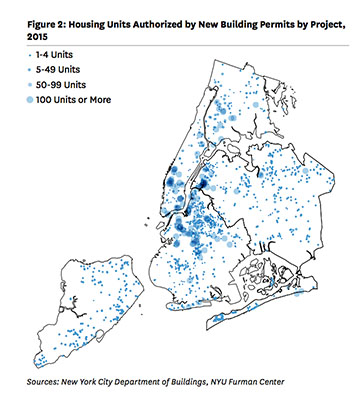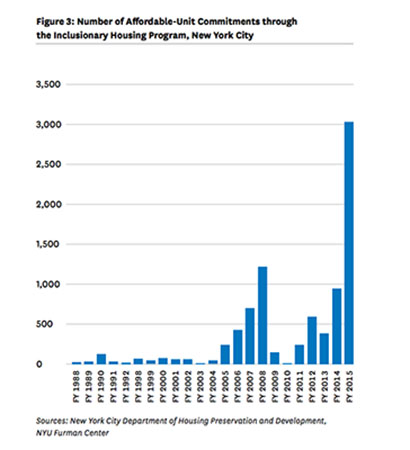Before it was mandatory, New York City’s inclusionary housing program created and preserved a record number of affordable housing units, according to a new report.
Developers last year committed to creating, preserving or rehabilitating more than 3,000 affordable units — three times the number seen in 2014, according to New York University Furman Center’s annual citywide housing report. The 3,000-plus units created in 2016 is also twice as many units created in any year since the program’s creation in 1987.
In March, the City Council approved Mayor Bill de Blasio’s mandatory inclusionary housing program, which requires developers who have received a residential rezoning to include a certain number of affordable units in their projects. It also mandates affordable housing construction in districts that have been rezoned, such as East New York.

In January, the mayor announced that the city — through a slew of programs — financed 7,179 new affordable apartments and preserved another 13,862 in 2015. Though the mayor touted the passage of MIH as a victory for his housing goal – to create and preserve 200,000 affordable units over the next decade — the program was largely overshadowed by the expiration of 421a. Developers and city officials have said that the absence of the property tax abatement will discourage the creation of rentals and affordable housing. Instead, they say, it will result in the construction of even more luxury condominiums.
The Furman report noted another impact of 421a: The deluge of permits issued for residential units. In 2015, permits authorized the construction of 51,342 residential units citywide — a 139 percent increase from 2014, when permits for 21,478 units were issued. Most of these units — 23,917 — were approved in Brooklyn, which saw a 217 percent year-over-year increase. Queens followed with 12,742 units, a nearly 200 percent jump from 2014. Permits issued in Manhattan authorized 10,313 units. The Bronx saw more than a 100 percent increase from 2014 in the number of units approved, logging 3,916 in 2015 over the prior year’s 1,957, according to the report. Meanwhile, Staten Island saw a 27 percent dip in units approved, dropping to 454 in 2015.

With the deadline for an extension of 421a looming, developers rushed to receive permits and begin construction before the program expired in January. Permits for 7,781 housing units across 299 projects were issued in December, the Wall Street Journal reported. This year is already off to a slower start. The Real Deal found that the city’s Department of Buildings approved only 453 units for construction in January, a number even lower than the average permits issued during the height of the financial crisis.
Of those 51,342 units approved in 2015, more than 39,000 were in residential buildings with 50 units or more — the highest number seen since 2004, according to the report. Overall, sales decreased year-over-year, due in large part to a 23 percent drop in condo sales from 10,411 to 8,493. The price range of these sales was not included in the report, but experts have been sounding the alarm on the softening ultra luxury market for some time now.
